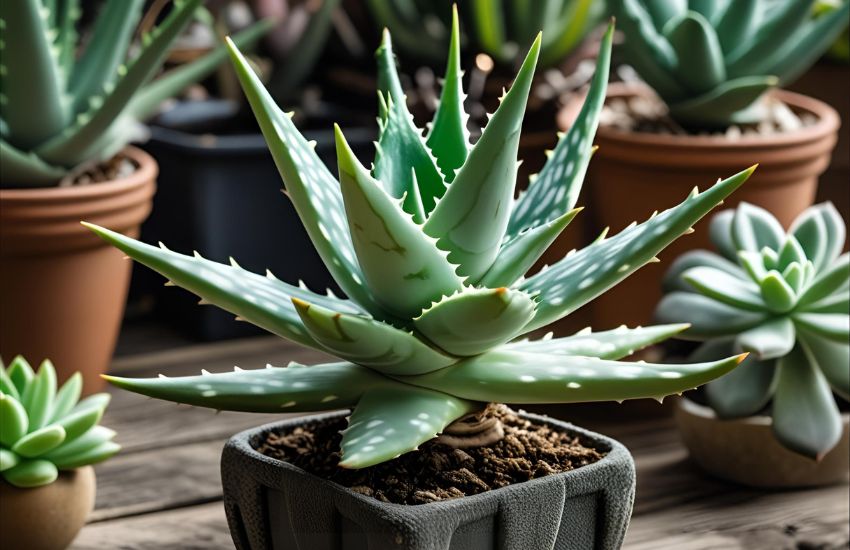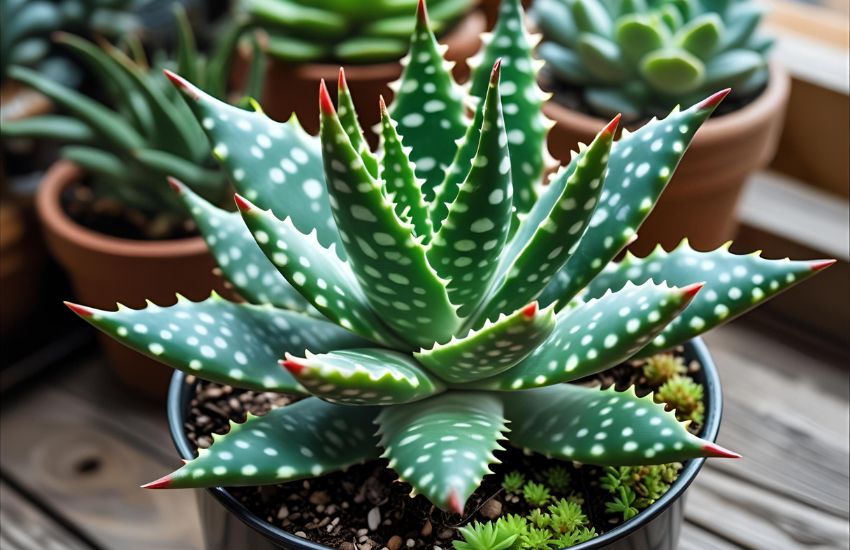Looking for a compact, low-maintenance plant that adds a refreshing touch of nature to your space? The Aloe Vera Green Mini Plant might be just what you need. Known for its succulent leaves and soothing properties, this plant is not only easy to grow but also perfect for small indoor spots like your window sill, work desk, or a sunny corner of your home. Its rich dark green foliage thrives in bright, indirect sunlight, making it an ideal choice even if you don’t have a full garden setup.
The Aloe Vera Green Mini Plant is a perfect indoor succulent plant choice, known for its low maintenance and air-purifying properties. Its compact size makes it ideal for desks, windowsills, or small spaces. With its soothing green leaves and natural healing benefits, this hardy plant adds beauty, freshness, and health to your indoor environment.
In this blog post, you’ll discover why the Aloe Vera Green Mini Plant is an ideal beginner-friendly choice. Learn how to grow, care for, and style this compact gem in your indoor or outdoors spot, with practical advice on sun, soil, pot, and water needs. Let’s help your succulent truly thrive.
Discover Why Aloe Vera Green Mini Plant Is Ideal Indoors

The Aloe Vera Green Mini Plant stands out as a perfect indoor companion, offering both aesthetic appeal and practical benefits. Its compact size and minimal care requirements make it a preferred choice for modern homes and workspaces. With bright green to light green, fleshy leaves, this plant adds a touch of freshness and calm to your environment while fitting neatly on desks, windowsills, or shelves.
This plant, also known as aloe, thrives in typical indoor temperature ranges between 18°C and 24°C. It tolerates indirect sunlight well but may begin to lose its vibrant color and slow in growth if the plant is not getting enough light. It’s important to monitor lighting conditions, especially in low-light rooms or during winter months.
One of its greatest advantages is its low watering needs. You should only water when the soil is dry, as overwatering can cause root issues. Since these plants require well-drained soil, always use a potting mix that prevents water retention to ensure healthy root development.
Another benefit of this succulent is its resistance to common indoor pest problems. However, occasional pests like mealybugs or aphids may still appear. Regular inspection of the leaves and prompt, gentle treatment can help keep the plant clean and healthy.
What makes this plant even more valuable is its medicinal nature. The soothing gel found in its leaves is often used to treat burns, hydrate skin, and support minor wound care. Having this medicinal plant within reach is especially useful during the dry winter season when your skin is more vulnerable.
Essential Aloe Plant Care Tips for Healthy Indoor Plant Growth

Caring for your indoor aloe plant requires a thoughtful approach to ensure healthy growth and long-term beauty. Aloe is a slow growing, perennial succulent that thrives with minimal intervention when given the right environment and attention. The following tips will help you maintain a vibrant and thriving aloe plant indoors.
Choose the Right Pot and Soil Mixture
To begin with, always use a container with drainage holes and a well-aerated soil mixture. Aloe plants are prone to root rot if water remains stagnant around their roots. A cactus or succulent potting mix is ideal, as it allows proper airflow and prevents moisture buildup.
Light Matters—but Don’t Overdo It
Your aloe plant loves sunlight, but avoid placing it in direct sunlight for extended periods, especially near windows with intense exposure. Too much direct light can cause brown leaves or stress the plant. Instead, place it where it gets plenty of bright, indirect sunlight for most of the day.
Water Sparingly and Monitor Closely
Aloe does not need frequent watering. Allow the soil to dry out completely between watering sessions. Overwatering is one of the most common causes of root rot in indoor aloe plants. During the colder months, you may water even less frequently, as the plant’s growth slows down.
Feed with Fertilizer—But Only Occasionally
To support healthy growth, use a balanced fertilizer diluted to half strength once or twice during the growing season (spring and summer). Avoid over-fertilizing, as aloe is sensitive to chemical build-up and can suffer more than benefit from excess feeding.
Prune for Aesthetic and Health
Regularly remove any dead or damaged leaves from the base of the plant. This not only improves the plant’s appearance but also prevents potential fungal problems. Use clean, sharp scissors or garden shears to avoid injuring the plant.
Keep an Eye on Color and Texture
Healthy aloe leaves are firm and vibrantly colored, ranging from pale green to pinkish hues under light stress. If your aloe starts turning pink at the tips, it may be reacting to changes in light or temperature. While this can be normal, it’s a signal to assess the plant’s environment to ensure it’s not under prolonged stress.
How Aloe Vera Plant Adds Beauty to Your Indoor Plant Collection

The Aloe Vera plant is more than just a healing succulent—it’s a timeless addition to any indoor plant collection. Its sculptural form, refreshing tones, and resilience make it an ideal choice for enhancing both modern and traditional interiors. With minimal care and remarkable aesthetic appeal, it brings a balanced combination of beauty and function to your home.
Architectural Elegance That Elevates Every Room
Aloe Vera’s rosette of thick, pointed leaves introduces a bold, structured look that instantly draws attention. Its muted green shades complement other indoor foliage while standing out with unique texture and shape. Whether placed on a shelf, a side table, or near a facing window, it easily becomes a design focal point in your living or working space.
A Natural Fit for Most Indoor Climates
This plant thrives in a variety of indoor climate conditions and adjusts well to dry conditions, making it a reliable addition to any home. Aloe Vera prefers bright, indirect light and performs best when placed near a sunny window. It’s particularly active during spring and summer, producing new growth that adds vitality and charm to your collection.
Practical and Low-Maintenance Elegance
Aloe Vera doesn’t just look good—it’s also incredibly easy to care for. Its ability to store water in its thick leaves allows it to flourish without frequent watering. Just ensure it’s planted in a container with proper drainage holes, and let the soil dry between waterings. This keeps the roots healthy and prevents overwatering issues.
Care Tips That Keep It Thriving
To maintain the plant’s vibrant appearance and support healthy growth, feed it lightly with a diluted, balanced nutrient solution during active growth periods. You may also need to repot it every few years, especially when it outgrows its current container or the soil becomes compacted. Repotting offers a chance to refresh the soil and promote stronger root development.
Conclusion
In conclusion, the Aloe Vera plant is a visually striking, hardy addition to your indoor plant collection that requires minimal upkeep. Its bold structure, low-maintenance needs, and adaptability to a wide range of environments make it a valuable choice for plant lovers of all experience levels. Unlike fussy houseplants, Aloe Vera thrives with ease, even in dry conditions and varying indoor climate settings.
With the right care—adequate sunlight, proper fertilization, well-draining soil, and protection from frost—your Aloe Vera will continue to enhance your space throughout the year. Just be cautious of overexposure to direct sun, which can cause sunburn on its fleshy leaves. Occasional repotting and routine maintenance will keep it healthy and beautiful for seasons to come.
Frequently Asked Questions (Aloe Vera Green Mini Plant: A Perfect Indoor Succulent Plant Choice)
How do you take care of a mini aloe vera plant?
A mini aloe vera plant thrives in bright, indirect sunlight and well-draining soil. Water it sparingly, allowing the soil to dry completely between waterings to prevent root rot. Keep it in a warm spot, away from drafts or frost. Fertilize lightly during the growing season and repot only when it outgrows its container.
Is aloe vera safe in the bedroom?
Yes, aloe vera is safe to keep in the bedroom. It releases oxygen at night, improving air quality and promoting better sleep. Additionally, it absorbs toxins like formaldehyde, making the environment healthier. Its low-maintenance nature and soothing appearance make it an ideal plant for bedrooms, benefiting both your health and décor.
Does the aloe plant like sun or shade?
Aloe plants prefer bright, indirect sunlight but can tolerate some direct sun. They thrive best in a sunny spot, such as near a window indoors or in partial shade outdoors. Too much direct sunlight can scorch the leaves, while too little light can cause weak, leggy growth. Balanced light ensures healthy, vibrant aloe plants.
Is aloe vera lucky inside the house?
Yes, aloe vera is considered a lucky plant to keep inside the house. It is believed to bring positive energy, good health, and prosperity while protecting against negative vibes. Besides its symbolism, aloe vera purifies the air and is easy to maintain, making it a practical and meaningful addition to any indoor space.
